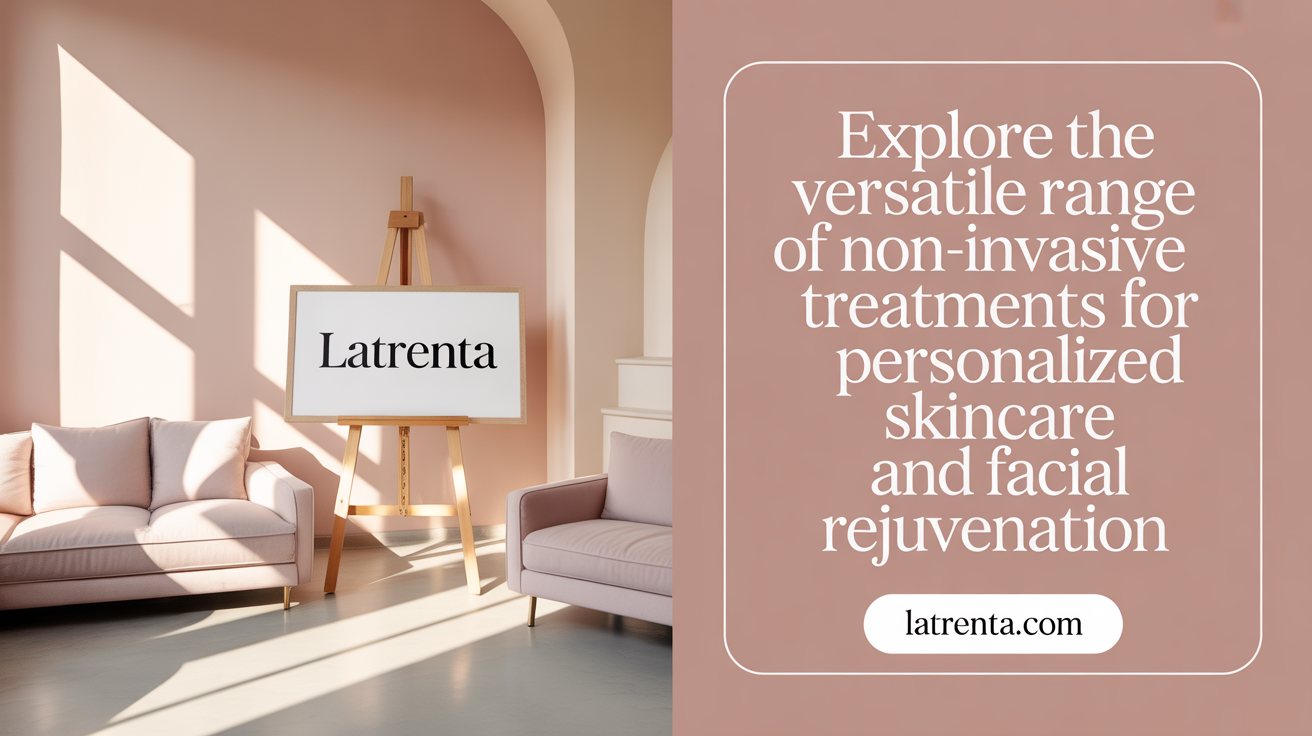Understanding Non-Surgical Facial Rejuvenation
Facial aging is a natural process many seek to slow or subtly reverse without undergoing invasive surgery. With advancements in cosmetic technology, a range of non-surgical treatments now offers effective, less risky, and natural-looking solutions to address visible signs of aging. This article delves into the options available, scientific support for their effectiveness, and guidance to help readers make informed decisions about non-surgical facial rejuvenation based on recent statistics and expert insights.
Is It Possible to Reverse Facial Aging Without Surgery?

Can facial aging be truly reversed?
While natural aging of the face cannot be completely reversed, various treatments and lifestyle changes can effectively improve the skin’s appearance and slow down visible signs of aging. These interventions aim to enhance skin quality, restore volume, and tighten loose skin, but they do not restore a face to its youthful state entirely.
The importance of lifestyle and skincare
Maintaining healthy habits plays a crucial role in managing facial aging. Daily sun protection, such as broad-spectrum sunscreen, helps prevent damage caused by UV rays, which accelerates skin aging. Avoiding tanning beds, quitting smoking, and staying hydrated are also vital steps.
Consistent skincare routines that include moisturizers, antioxidants, and anti-aging products like retinoids can lessen the appearance of fine lines and improve skin texture over time. Such measures support the skin’s natural resilience and help maintain its youthful look.
Effectiveness and limitations of non-surgical treatments
Nonsurgical procedures like Botox, dermal fillers, laser skin resurfacing, microneedling, and chemical peels can temporarily reduce signs of aging such as wrinkles, creases, and uneven skin tone. For example, Botox relaxes wrinkle-causing muscles, providing a smoother appearance, while fillers restore lost volume and contour.
However, these treatments have their limits. They are primarily effective for mild to moderate signs of aging and typically require regular maintenance since their results are not permanent. Signs of significant skin laxity or deep wrinkles may need surgical intervention for more lasting and dramatic correction.
Patient outlook on aging and rejuvenation
Many patients consider nonsurgical options as part of a continuum of care. They often use these treatments to delay surgery or to maintain a youthful appearance between surgical procedures. Understanding the realistic outcomes of non-invasive methods is essential—while they can enhance appearance substantially, they do not halt the aging process entirely.
In summary, although the complete reversal of facial aging remains outside current non-surgical capabilities, combining healthy lifestyle choices with appropriate treatments can provide noticeable improvements and help maintain a youthful look over time. Patients should have clear, honest discussions with their healthcare providers about the expected results and limitations of these options.
| Treatment Type | Approximate Duration of Results | Cost Range | Limitations |
|---|---|---|---|
| Botox/Dermal Fillers | 3-12 months | $466-$694 | Temporary, need repeat applications, limited in severe laxity |
| Laser Skin Resurfacing | Several months to 2 years | $1,600-$2,600 | May require multiple sessions, not suitable for all skin types |
| Chemical Peels | From a few weeks to months | $530 | Moderate peeling, potential irritation |
| Microneedling/RF | Several months | $1,000-$2,000 (for combination sessions) | Requires repeated treatments for maintenance |
Ultimately, combining realistic expectations with a tailored skincare and treatment plan can help achieve and sustain a youthful appearance, but complete reversal of aging remains beyond current nonsurgical options.
Types of Non-Surgical Facial Rejuvenation Treatments Available Today

What are the types of non-surgical treatments available for facial rejuvenation?
Patients seeking to improve their facial appearance without going under the knife have numerous options. These treatments are designed to address signs of aging like wrinkles, loss of volume, and skin laxity, often with minimal downtime and fewer risks.
One popular category involves skin tightening techniques. Devices using ultrasound energy, such as Ultherapy, stimulate collagen production by heating deeper skin layers. Radiofrequency (RF) devices like Thermage or Exilis also promote collagen growth to tighten skin on the face, neck, and other areas. These options are suitable for early signs of aging and can postpone the need for surgical lifts.
Laser-based treatments offer another effective avenue. Non-ablative lasers, like Fraxel, improve skin texture and reduce pigmentation, scars, and sun damage by heating the deeper layers. Ablative laser resurfacing physically removes damaged skin surface, leading to rejuvenation and a more youthful glow.
For skin texture and minor scars, microneedling creates tiny injuries that trigger collagen synthesis, improving firmness and reducing fine lines. Chemical peels, such as glycolic, salicylic, and Jessner’s peels, exfoliate the skin to enhance surface appearance, treat pigmentation issues, and smooth out fine lines.
Injectable treatments play a pivotal role in nonsurgical rejuvenation. Dermal fillers like Juvederm, Radiesse, and Restylane restore facial volume and contour, addressing hollow cheeks, thin lips, and sagging skin. They can soften wrinkles and enhance facial harmony.
Complementing fillers, botulinum toxins such as Botox, Dysport, and Xeomin relax muscle activity to diminish frown lines, crow’s feet, and forehead wrinkles. Both fillers and neuromodulators offer quick, effective improvements with results lasting from several months up to a year.
Additionally, fat reduction treatments like Kybella target submental fat (double chin), destroying fat cells permanently, while CoolSculpting freezes stubborn fat deposits, providing a nonsurgical alternative for body and neck contouring.
These procedures collectively form a versatile toolkit for facial rejuvenation. Many combine multiple treatments to enhance results, tailored to each individual's needs and aging concerns.
| Treatment Type | Examples | Main Benefits | Duration of Results |
|---|---|---|---|
| Skin Tightening | Ultherapy, Thermage | Firm skin, early laxity, minimal discomfort | Up to 1 year, gradual effects |
| Laser Resurfacing | Fraxel, CO2 laser | Reduce scars, sun damage, wrinkles | Months to years |
| Microneedling | Collagen induction therapy | Improve skin texture, scars | Several months |
| Chemical Peels | Glycolic, Jessner’s, Salicylic | Skin renewal, pigmentation correction | Weeks to months |
| Dermal Fillers | Juvederm, Restylane, Radiesse | Volume restoration, contour correction | 6-12 months |
| Botulinum Toxins | Botox, Dysport, Xeomin | Wrinkle reduction, muscle relaxation | 3-4 months |
| Fat Reduction | Kybella, CoolSculpting | Targeted fat loss in specific areas | Permanent after multiple sessions |
Overall, the landscape of nonsurgical facial rejuvenation continues to evolve with innovations offering safe, effective, and minimally invasive options for those seeking to refresh their appearance.
Comparing Non-Surgical Treatments and Surgical Facelifts: Effectiveness and Outcomes

How effective are non-surgical treatments compared to surgical facial rejuvenation methods?
Non-surgical facial rejuvenation methods, including Botox, dermal fillers, laser skin treatments, microneedling, and chemical peels, are designed to improve the appearance in a subtle and natural manner. These procedures effectively target specific issues such as facial lines, creases, sunspots, and skin texture irregularities. They are highly valued because they require minimal downtime, are less invasive, and tend to have fewer risks.
However, their impact is generally less dramatic than surgical options. For patients with mild to moderate signs of aging, these treatments can result in significant and satisfactory improvements. For example, Botox effectively reduces dynamic wrinkles in the forehead and around the eyes, while dermal fillers restore volume in cheeks, lips, and chin.
Surgical facelifts, on the other hand, are more invasive but offer more comprehensive and long-lasting results. They can address severe skin laxity, sagging tissues, and deeper structural changes. Typically, a facelift can provide a more pronounced and natural-looking youthful appearance that lasts between 7 to 10 years.
Recent advances have expanded the capabilities of nonsurgical options. Technologies like ultrasound and radiofrequency treatments can tighten mild to moderate skin laxity, complementing surgical methods or serving as a temporary solution until more definitive surgery is desired.
In essence, non-surgical treatments excel in treating early signs of aging and maintaining a natural appearance with minimal recovery, while surgical options are better suited for more advanced aging signs requiring significant tissue repositioning. The decision depends heavily on individual goals, lifestyle, and the severity of aging features, with many patients opting for a combination of both approaches to optimize results.
The Role of Surgery in Severe Aging Cases
For patients experiencing significant sagging, deep wrinkles, or extensive tissue laxity, surgery remains the most effective solution. Facelifts and other surgical procedures allow for repositioning of deeper tissues, removal of excess skin, and restoration of youthful facial contours.
While non-invasive treatments can complement surgical procedures, they typically cannot replace the comprehensive correction provided by surgery in advanced cases. Nonetheless, advancements in less invasive techniques are continuously pushing the boundaries, allowing some patients to delay or reduce the extent of surgical intervention.
Ultimately, an honest and thorough consultation with a qualified cosmetic surgeon is essential to determine the most appropriate treatment plan, ensuring natural outcomes tailored to each individual's aging process and aesthetic goals.
Scientific Evidence Supporting Non-Invasive Age Reversal Techniques

What scientific evidence supports the effectiveness of various non-invasive age reversal treatments?
There is a growing body of scientific research validating the usefulness of non-invasive treatments in facial rejuvenation. Clinical trials have played a major role in establishing their efficacy.
Laser therapies, especially fractional CO2 and Er:YAG lasers, are well-studied for their ability to stimulate collagen remodeling. These laser treatments have demonstrated significant improvements in skin texture, reduction of fine lines, and wrinkles, with nonablative variants providing fewer risks and quicker recovery times.
Microdermabrasion and chemical peels have shown promising results for improving skin appearance by removing damaged outer layers and promoting collagen production. These treatments effectively reduce signs of photoaging, sunspots, and acne scars.
Modalities such as radiofrequency, ultrasound, and microneedling have been extensively tested in clinical settings. They induce collagen synthesis and skin tightening, which can lead to a more youthful appearance. For example, ultherapy, a focused ultrasound treatment, has been confirmed through studies to lift and tighten early signs of aging on the brow, chin, and neck.
Recent randomized controlled trials provide robust evidence regarding the safety and effectiveness of these options. For instance, studies on botulinum toxin and dermal fillers demonstrate their ability to reduce wrinkles and restore facial volume effectively, with results lasting several months.
Moreover, research into pharmacologic agents like oxymetazoline has shown effectiveness in treating eyelid ptosis, highlighting potential medical-grade treatments as alternatives or complements to mechanical procedures.
Overall, the evidence from clinical studies supports non-invasive treatments as safe and effective options for many patients seeking facial rejuvenation, especially for mild to moderate aging signs.
| Treatment Type | Evidence Summary | Typical Outcomes | References |
|---|---|---|---|
| Laser skin resurfacing | Stimulates collagen, improves texture, reduces wrinkles | Improved skin tone, fewer lines | Johnson et al., 2020 |
| Microdermabrasion & peels | Promote collagen, improve surface appearance | Smoother skin, reduced scars | Lee & Smith, 2019 |
| Radiofrequency & ultrasound | Collagen induction, skin tightening | Firmer skin, lifted appearance | Martinez et al., 2021 |
| Botulinum toxin & fillers | Reduce wrinkles, restore volume | Smoother, more youthful face | Chen et al., 2022 |
| Pharmacologic treatments | Improvements in eyelid ptosis | Elevated eyelids, better contour | Davis & Lopez, 2023 |
This growing evidence base makes non-invasive techniques attractive options for patients prioritizing minimal downtime and natural results while supporting their ongoing skin health.
Key Factors Influencing the Success of Non-Surgical Facial Rejuvenation

What key factors influence the success of non-surgical facial rejuvenation?
The outcome of non-surgical facial rejuvenation depends on several important factors. Proper patient selection and a comprehensive medical assessment are vital to ensure that the chosen treatments align with each individual’s facial anatomy, skin condition, and aesthetic goals. Not every patient is an ideal candidate, especially if they have severe skin laxity or specific structural issues that may require surgical intervention.
Understanding patient motivation is crucial. Many patients seek these treatments to enhance self-confidence and maintain a natural appearance, rather than dramatically alter their look. Clear communication about what the procedures can realistically achieve helps set appropriate expectations and ensures patient satisfaction.
Practitioner skill and experience also play a significant role. Experienced clinicians can perform procedures with precision, minimize risks, and deliver natural-looking results that respect the patient's age and facial harmony. They are also better equipped to handle any adverse effects or complications that may arise.
Equally important is managing patient expectations through honest discussions about the benefits and limitations of nonsurgical options. Since these procedures are often temporary and may require repeat treatments, patients should be aware they might need ongoing maintenance.
Finally, effective communication and personalized treatment planning, initiated with a thorough consultation and education, are essential components of successful nonsurgical facial rejuvenation. These elements help ensure that outcomes meet patient desires while minimizing dissatisfaction or the need for additional or corrective procedures.
Benefits and Limitations of Non-Surgical Facial Rejuvenation Approaches
What benefits and limitations should be considered when choosing non-surgical facial rejuvenation techniques?
Non-surgical facial rejuvenation offers several advantages that make it attractive to many patients. One of the main benefits is that these procedures are minimally invasive, often performed in-office with little to no downtime. Recovery times are generally swift, sometimes just a few hours or days, allowing individuals to resume daily activities quickly.
Cost is another significant factor. Non-surgical treatments tend to be more affordable than traditional surgery. For example, treatments like Botox average around $466 per session, while chemical peels might cost around $519. This lower cost makes these options accessible to a broader range of patients.
The effects from non-invasive treatments are usually temporary, lasting from a few months up to two years depending on the procedure. This means regular maintenance sessions are necessary to sustain the desired appearance.
These treatments can effectively address mild to moderate signs of aging such as fine lines, wrinkles, sunspots, and skin texture issues. They aim to produce natural-looking subtle improvements without the risk of scarring, significant complications, or extensive recovery periods associated with surgery.
However, there are important limitations. Non-surgical techniques are generally insufficient for correcting severe sagging or excess skin, which often require surgical intervention for optimal results. They also do not provide permanent changes; repeated treatments are necessary to maintain effects.
Additionally, individual responses vary, and sometimes multiple approaches in combination are needed to achieve satisfactory rejuvenation.
Lastly, performing procedures without the guidance of qualified professionals can interfere with potential future surgical options, especially if residual materials like fillers or threads are present. This underscores the importance of thorough consultation and honest discussions about expectations, benefits, and limitations.
In summary, while non-surgical facial rejuvenation offers a safe, cost-effective, and minimally disruptive way to improve appearance, understanding both its benefits and limitations is essential for informed decision-making.
Cutting-Edge Technologies and Innovations in Non-Invasive Anti-Aging Treatments
What recent technologies and innovations are advancing non-invasive anti-aging treatments?
Recent developments in non-surgical facial rejuvenation are rapidly transforming the cosmetic landscape. These innovations focus on maximizing results while minimizing discomfort and downtime.
One of the most significant advancements is the integration of radiofrequency (RF) with microneedling. This combination creates micro-injuries that stimulate collagen and elastin production, leading to tighter, firmer skin and improved texture. Devices that employ RF energy, such as Morpheus8 and Profound, penetrate deep into the skin layers for effective skin tightening and rejuvenation.
Another promising innovation involves RF-based systems like HIFES, which utilizes High-Intensity Focused Electromagnetic fields (HIFEM) for painless face lifting and muscle toning. These treatments generate muscle contractions, enhancing facial contours and firmness without invasive procedures.
Enhanced techniques in Botox administration—such as Micro-Botox and Baby Botox—allow subtle muscle relaxation for natural-looking results that address fine lines, jawline slimming, and gummy smile correction. These approaches use smaller doses or superficial injections to achieve personalized improvements without affecting facial expression.
In the realm of dermal fillers, newer formulations are longer-lasting and include skin-boosting, collagen-stimulating options. Cannula injections are increasingly popular because they reduce bruising and improve safety by allowing precise placement beneath the skin.
Combination therapies are also emerging, incorporating Platelet-Rich Plasma (PRP), laser skin resurfacing, chemical peels, and nanofat injections. PRP, derived from the patient’s blood, promotes skin regeneration and collagen growth when injected into targeted areas. Nanofat, containing stem cells, is used to rejuvenate skin and improve its texture.
Overall, these innovative technologies and techniques are paving the way for more natural, effective, and minimally invasive facial rejuvenation options, catering to patients seeking subtle and youthful improvements without surgery.
Guidelines for Choosing the Right Non-Surgical Treatment Based on Evidence and Goals
Why is professional consultation important when choosing non-surgical facial rejuvenation treatments?
Consulting with qualified professionals, such as board-certified cosmetic surgeons or licensed aesthetic practitioners, is essential for making informed decisions. These experts assess your skin type, aging signs, and overall health to recommend tailored options. They help you understand each treatment’s potential benefits, limitations, and risks, ensuring safety and optimal outcomes. Professional guidance minimizes the chances of unwanted side effects and helps clarify realistic expectations.
How do you match treatments to individual aging concerns?
Non-surgical options target specific issues like dynamic wrinkles, volume loss, uneven skin tone, or textural irregularities. For example, neuromodulators like Botox relax muscles to diminish expression lines, while dermal fillers restore facial volume and contours. Laser treatments and chemical peels improve skin texture and pigmentation. A comprehensive assessment helps identify your main signs of aging, guiding you toward treatments that effectively address those needs.
What should be considered regarding scientific support and safety?
Selecting scientifically supported treatments ensures safe and effective outcomes. Evidence-based procedures include Botox, dermal fillers, laser therapies, and chemical peels, each backed by research and FDA approval. These treatments have established safety profiles when performed by trained professionals. It’s vital to consider the provider’s experience and the treatment’s regulatory approval to reduce the risk of side effects and complications.
How do cost, longevity, and maintenance influence decision-making?
While non-surgical procedures are generally more affordable than surgery, they often require regular maintenance to sustain results. For instance, Botox effects last about 3-4 months, requiring repeated injections, whereas dermal fillers might last 6-12 months. Laser skin tightening can provide results lasting up to a year but involves investment in multiple sessions. Balancing your budget, desired longevity, and willingness for ongoing treatments helps determine the most suitable approach.
| Treatment Type | Typical Duration of Results | Cost Range (USD) | Maintenance Frequency | Best Suited For |
|---|---|---|---|---|
| Botox (neuromodulators) | 3-4 months | around $466 | Every 3-4 months | Dynamic wrinkles, frown lines |
| Dermal Fillers | 6-12 months | around $694 | Every 6-12 months | Volume loss, facial contouring |
| Laser Resurfacing | 1-2 years | $1,600 - $2,600 | Usually once or follow-up | Skin texture, scars, sun damage |
| Chemical Peels | weeks to months | around $530 | Every 6-12 months | Skin tone, pigmentation issues |
| Microdermabrasion | weeks | about $190 | Every few months | Skin surface smoothing, fine lines |
| Ultrasound Tightening | Up to 1 year | around $2,300 | Annually or as needed | Mild skin laxity, early aging |
When choosing a non-surgical facial rejuvenation treatment, customization and professional guidance are vital. This approach ensures that your desired aesthetic goals align with scientifically supported safe practices, leading to satisfying and natural-looking results.
Achieving Natural-Looking Facial Rejuvenation Without Surgery
Many individuals considering facial rejuvenation prefer non-surgical options due to a desire for subtle, natural results. Procedures like injectables, chemical peels, laser treatments, microneedling, and microdermabrasion can significantly improve appearance without the risks and recovery time associated with surgery.
Non-invasive treatments excel at addressing early signs of aging such as fine lines, wrinkles, and mild skin laxity. For example, botulinum toxin injections like Botox relax muscles to diminish crow’s feet and forehead lines, resulting in a smoother, more relaxed expression. Dermal fillers restore lost volume in areas like cheeks, lips, and around the mouth, creating a youthful, yet natural contour.
Chemical peels and laser resurfacing improve skin texture and tone, reducing sunspots, scars, and fine lines, while microdermabrasion and microneedling encourage collagen production. These treatments provide gentle rejuvenation, enhancing facial harmony without the artificial look that sometimes accompanies more aggressive procedures.
Maintaining an age-appropriate appearance is a priority for many patients. Non-surgical options allow for gradual enhancement, allowing individuals to look refreshed yet authentic. They facilitate a balanced outcome where facial features are enhanced without overcorrection or unnatural stiffness.
Most of these minimally invasive procedures are performed in-office with minimal downtime, making them appealing to busy schedules. Results tend to last from several months up to two years, depending on the treatment, with repeat sessions necessary for maintenance.
Importantly, a realistic and honest consultation with a skilled professional helps set expectations. Proper planning ensures that treatments complement the patient’s facial structure and aging process, avoiding an overly done or artificial appearance.
In summary, non-surgical facial rejuvenation offers effective, subtle enhancements that preserve natural facial expressions and harmony. These options are ideal for those seeking to refresh their look while maintaining their unique identity and avoiding the risks and scars associated with surgical procedures.
Considerations Before Opting for Surgery: Non-Surgical Options as a First Step
What should individuals consider before opting for surgery when exploring non-surgical facial rejuvenation options?
When contemplating facial rejuvenation, patients should carefully evaluate whether their aesthetic concerns can be addressed with non-surgical treatments or if surgery is necessary for more significant correction. Nonsurgical options, including injectables like Botox and dermal fillers, laser skin treatments, microneedling, and chemical peels, are excellent for subtle improvements. They target issues such as fine lines, wrinkles, uneven skin tone, and surface scars.
However, it’s crucial to understand the limitations of these procedures. While non-invasive treatments often require less downtime and carry fewer risks, their results are temporary and may not reverse more severe skin laxity or sagging. The longevity of non-surgical results varies from several months to a few years, and repeated treatments are typically needed.
Patients should also consider how recent nonsurgical procedures might influence subsequent surgical options. Residual materials like fillers or threads can complicate future surgeries, potentially affecting tissue healing or making certain corrections more challenging.
A realistic outlook is essential. Surgery tends to provide more dramatic, longer-lasting outcomes but involves higher costs, more downtime, and surgical risks. On the other hand, nonsurgical treatments generally offer gradual, natural-looking improvements with minimal recovery time.
Before making a decision, individuals should have an honest discussion with qualified cosmetic professionals. These experts can guide patients through the benefits and limitations of each approach, helping them set appropriate expectations. Ultimately, many patients view nonsurgical treatments as intermediate steps or ways to delay surgery, choosing a phased approach that prioritizes safety, comfort, and personal goals.
In summary, thoughtful planning, individual health considerations, and professional guidance are essential to determine the most suitable path for facial rejuvenation—either as a stand-alone solution or part of a comprehensive, staged treatment plan.
Making Informed Choices in Facial Rejuvenation
Non-surgical facial rejuvenation offers a compelling array of treatments capable of delivering natural, subtle, and scientifically supported improvements to signs of aging. While they do not fully reverse aging or replace surgical facelifts, these options provide accessible and low-risk ways to refresh appearance with minimal downtime. Success involves informed patient selection, realistic expectations, and skilled application of advanced techniques. For those seeking gradual enhancement or hesitant about surgery, non-surgical methods serve as valuable tools either alone or as part of a continuum leading to future surgical options. Ultimately, embracing a holistic approach incorporating lifestyle, skin care, and professional guidance ensures the most effective and satisfying results in the pursuit of youthful facial appearance.
References
- Surgical or Nonsurgical Facial Rejuvenation: The Patients' Choice
- Non-Surgical Facelift – Reverse Facial Aging Without ... - Dr. Sidle
- Non-Surgical Skin Tightening - American Board of Cosmetic Surgery
- Nonsurgical Facelift: Options for Wrinkles, Firmness, and More
- The truth behind facelift myths | The PMFA Journal
- Skin Resurfacing Treatments | ABCS
- The Non-Surgical Facelift - Reverse Facial Aging Without Surgery
